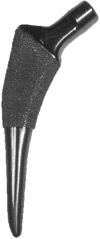Two- to 4-Year Followup of a Short Stem THA Construct: Excellent Fixation, Thigh Pain a Concern
- PMID: 27417852
- PMCID: PMC5213930
- DOI: 10.1007/s11999-016-4974-1
Two- to 4-Year Followup of a Short Stem THA Construct: Excellent Fixation, Thigh Pain a Concern
Abstract
Background: Short stem cementless femoral components were developed to aid insertion through smaller incisions, preserve metaphyseal bone, and potentially decrease or limit the incidence of thigh pain. Despite some clinical success, the senior author (DDG) believed a higher percentage of his patients who had received a cementless short stem design were experiencing thigh pain, which, coupled with concerns about bone ingrowth fixation, motivated the review of this case series.
Questions/purposes: (1) What is the proportion of patients treated with a short stem cementless THA femoral component that develop thigh pain and what are the hip scores of this population? (2) What are the radiographic results, specifically with respect to bone ingrowth fixation and stress shielding, of this design? (3) Are there particular patient or procedural factors that are associated with thigh pain with this short stem design?
Methods: Two hundred sixty-one primary THAs were performed in 238 patients by one surgeon between November 2010 and August 2012. During this time period, all patients undergoing primary THA by this surgeon received the same cementless short titanium taper stem. Seven patients (eight hips) died and five patients (five hips) were lost to followup, leaving 226 patients (248 hips) with a mean followup of 3 years (range, 2-5 years). Patients rated their thigh pain during activity or rest at final followup on a 10-point visual analog scale. Harris hip scores (HHS) were obtained at every clinic appointment. Thigh pain was evaluated at the final followup or by contacting the patient by phone. Radiographs were evaluated for bone-implant fixation, bone remodeling, and osteolysis. An attempt was made to correlate thigh pain with patient demographics, implant specifications, or radiographic findings.
Results: Seventy-six percent of hips (180 of 238) had no thigh pain, 16% of hips (37 of 238) had mild thigh pain, and 9% (21 of 238) had moderate or severe thigh pain. Preoperatively, mean HHS was 47 (SD, 16) and at last followup, mean HHS was 88 (SD, 13). There were two femoral revisions, one for severe thigh pain and the other for infection. All but two components demonstrated bone ingrowth fixation (99%). Femoral stress shielding was mild in 64% of hips (135 of 212), moderate in 0.5% (one of 212), and severe in no hips. There is an inverse linear relationship between age and severity of thigh pain (r = -0.196; p < 0.0024).
Conclusions: Although reliable fixation was achieved and good HHS were attained, the frequency and severity of thigh pain with this short cementless stem were concerning. The surgeon has subsequently abandoned this short stem design and returned to a conventional length stem. Future study direction might investigate the biomechanical grounds for the thigh pain associated with this stem design.
Level of evidence: Level IV, therapeutic study.
Figures



Comment in
-
CORR Insights®: Two- to 4-year Followup of a Short Stem THA Construct: Excellent Fixation, Thigh Pain a Concern.Clin Orthop Relat Res. 2017 Feb;475(2):384-386. doi: 10.1007/s11999-016-5019-5. Epub 2016 Aug 9. Clin Orthop Relat Res. 2017. PMID: 27506972 Free PMC article. No abstract available.
Similar articles
-
Ultrashort versus Conventional Anatomic Cementless Femoral Stems in the Same Patients Younger Than 55 Years.Clin Orthop Relat Res. 2016 Sep;474(9):2008-17. doi: 10.1007/s11999-016-4902-4. Epub 2016 Jun 3. Clin Orthop Relat Res. 2016. PMID: 27260482 Free PMC article. Clinical Trial.
-
Long-term results and bone remodeling after THA with a short, metaphyseal-fitting anatomic cementless stem.Clin Orthop Relat Res. 2014 Mar;472(3):943-50. doi: 10.1007/s11999-013-3354-3. Epub 2013 Oct 26. Clin Orthop Relat Res. 2014. PMID: 24163094 Free PMC article.
-
Can a Conical Implant Successfully Address Complex Anatomy in Primary THA? Radiographs and Hip Scores at Early Followup.Clin Orthop Relat Res. 2016 Feb;474(2):459-64. doi: 10.1007/s11999-015-4480-x. Clin Orthop Relat Res. 2016. PMID: 26245165 Free PMC article.
-
Low Reinfection Rates But a High Rate of Complications in THA for Infection Sequelae in Childhood: A Systematic Review.Clin Orthop Relat Res. 2021 May 1;479(5):1094-1108. doi: 10.1097/CORR.0000000000001607. Clin Orthop Relat Res. 2021. PMID: 33617159 Free PMC article.
-
A systematic review of short metaphyseal loading cementless stems in hip arthroplasty.Bone Joint J. 2019 May;101-B(5):502-511. doi: 10.1302/0301-620X.101B5.BJJ-2018-1199.R1. Bone Joint J. 2019. PMID: 31037973
Cited by
-
Short-term clinical and radiological results of two different design metaphyseal fitting femoral stems in total hip arthroplasty: a prospective, randomized trial.J Orthop Surg Res. 2021 May 17;16(1):316. doi: 10.1186/s13018-021-02465-8. J Orthop Surg Res. 2021. PMID: 34001204 Free PMC article. Clinical Trial.
-
Promising medium-term results of anterior approach with an anatomical short stem in primary hip arthroplasty.J Orthop Traumatol. 2021 Mar 6;22(1):8. doi: 10.1186/s10195-021-00567-x. J Orthop Traumatol. 2021. PMID: 33675436 Free PMC article.
-
Uncemented short stems in primary total hip arthroplasty: The state of the art.EFORT Open Rev. 2018 May 9;3(5):149-159. doi: 10.1302/2058-5241.3.170052. eCollection 2018 May. EFORT Open Rev. 2018. PMID: 29951251 Free PMC article.
-
A shortened uncemented stem offers comparable positioning and increased metaphyseal fill compared to a standard uncemented stem.J Exp Orthop. 2019 Jun 25;6(1):28. doi: 10.1186/s40634-019-0197-1. J Exp Orthop. 2019. PMID: 31240502 Free PMC article.
-
Malalignment and distal contact of short tapered stems could be associated with postoperative thigh pain in primary total hip arthroplasty.J Orthop Surg Res. 2021 Jan 19;16(1):67. doi: 10.1186/s13018-021-02215-w. J Orthop Surg Res. 2021. PMID: 33468189 Free PMC article.
References
-
- Barrack RL, Jasty M, Bragdon C, Haire T, Harris WH. Thigh pain despite bone ingrowth into uncemented femoral stems. J Bone Joint Surg Br. 1992;74:507–510. - PubMed
MeSH terms
LinkOut - more resources
Full Text Sources
Other Literature Sources
Medical
Research Materials

